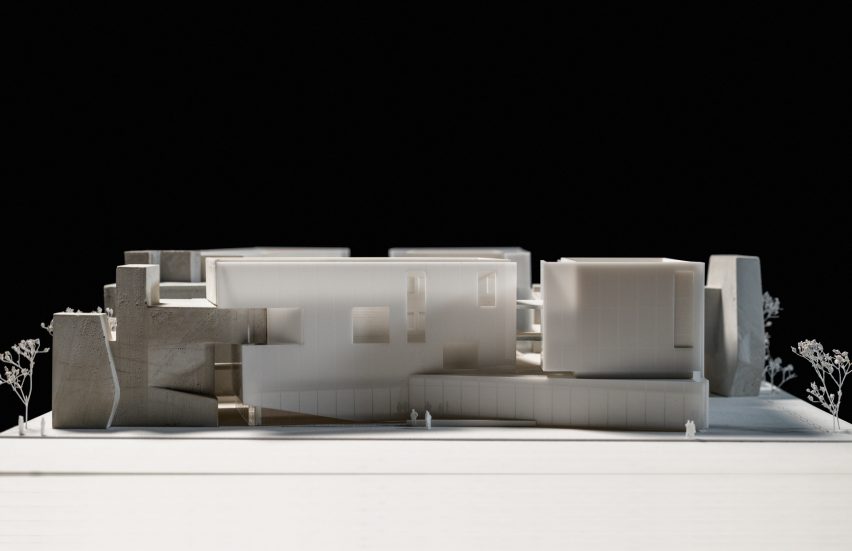
Kent State University spotlights 10 architecture student projects
Dezeen School Shows: collective living spaces that manifest human-like characteristics are included in Dezeen's latest school show by students at Kent State University.
Also included is a building facade that mimics the illusions created by a kaleidoscope and a building informed by the ecology of its site.
Kent State University
Institution: Kent State University
School: College of Architecture and Environmental Design
Courses: Architecture Undergraduate and Graduate Programmes
Tutors: Sung Ho Kim, Iván Bernal, Matthew Hutchinson, Jean Jaminet, Jonathan MacGillis, Andrew Economos Miller, Ebrahim Poustinchi, Nick Safleya and Jon Yoder
School statement:
"The architecture programmes at Kent State University are committed to offering a transformational architectural education that pursues experimental and creative design thinking.
"The programmes prepare innovative architects and leaders in the community by empowering graduates with the passion, skills, craft and expertise to envision the future of the built environment.
"The following projects display different levels across various years in both undergraduate and graduate programmes, covering design topics of sustainability, spatial and programmatic complexity, urban design, technology, systems integration and representation.
"We believe in exposing our students to contemporary issues of theory, advanced technical skills as well as social and cultural context to create an integrated platform for scholarship, design excellence and constructive discourse within the architectural discipline."
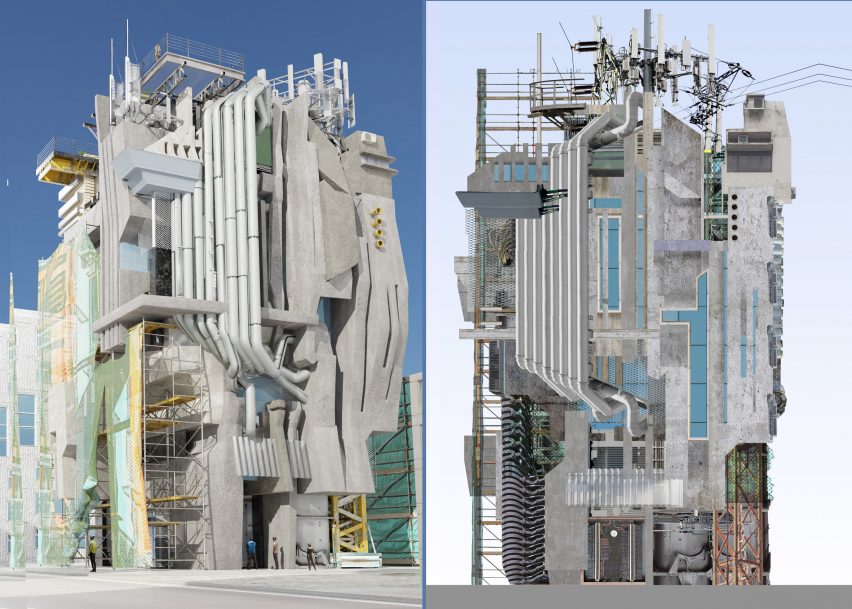
Missoni Check Pattern Critique by Andrew Arunski
"Missoni Check Pattern Critique explores the relationship between tectonics and textile production, which are both complicated by computation and virtual modes of viewing through digital image making.
"Textural considerations create incongruities between the scale of the detail and that of the body, producing eccentricities between textile patterning, tectonic expression and associated material effects.
"Here, the architecture explores the scale and projection of body imaging throughout the building."
Student: Andrew Arunski
Course: Second Year Design Studio II
Tutor: Jean Jaminet
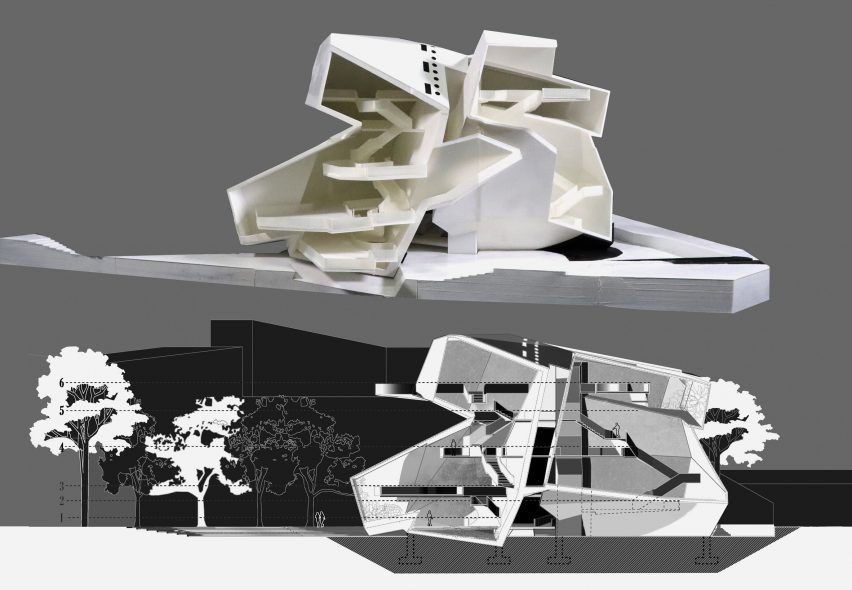
Cultural Garden in Kent, Ohio by Delan Lara
"Cultural Garden in Kent, Ohio, employs the established concepts of object inside object and object above object.
"It aims to revisit the part-to-part and the part-to-whole relationships between the interior and building envelope as well as building and site context negotiations, utilising volumetric and organisational articulations.
"Using site, massing and interiority as 'objectified' intellectual spatial tools and mediums, the studio investigates the 'object-hood' and 'object-ness' of the space through user experience at multiple scales."
Student: Delan Lara
Course: Third Year Design Studio I
Tutor: Ebrahim Poustinchi
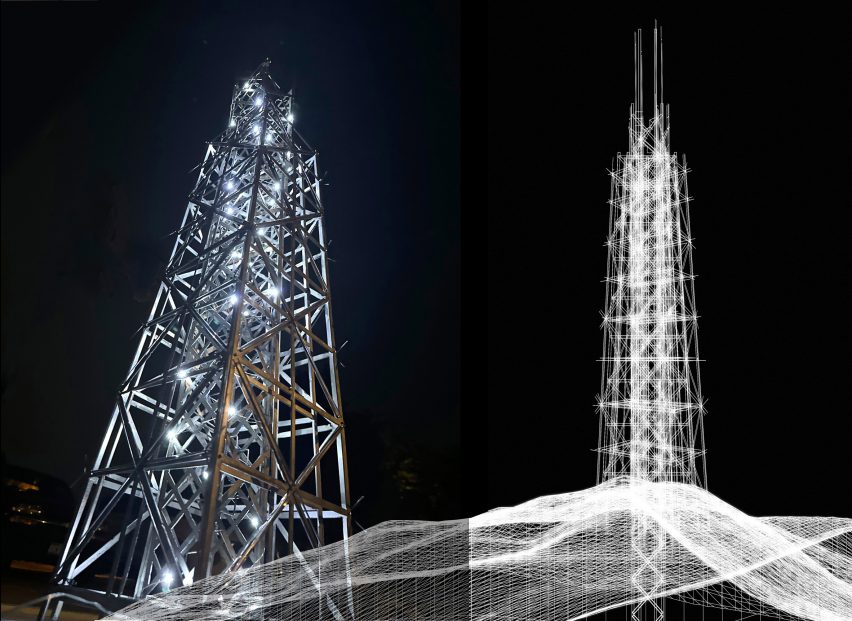
Observate One by Kurt R Roscoe
"Observate One is an observation tower comprised of three nested truss tower structures.
"Beginning with the inner core tower that is situated underground, the core tower extends vertically above the other two structures – the result is a series of three towers that appear to extend skyward.
"This project explores the notion that architectural image culture is expanding and complex imaging systems such as virtual reality, 3D scanning and texture mapping are gradually replacing the traditional trope of line drawings in architectural education."
Student: Kurt R Roscoe
Course: Graduate Design Studio II
Tutor: Jon Yoder
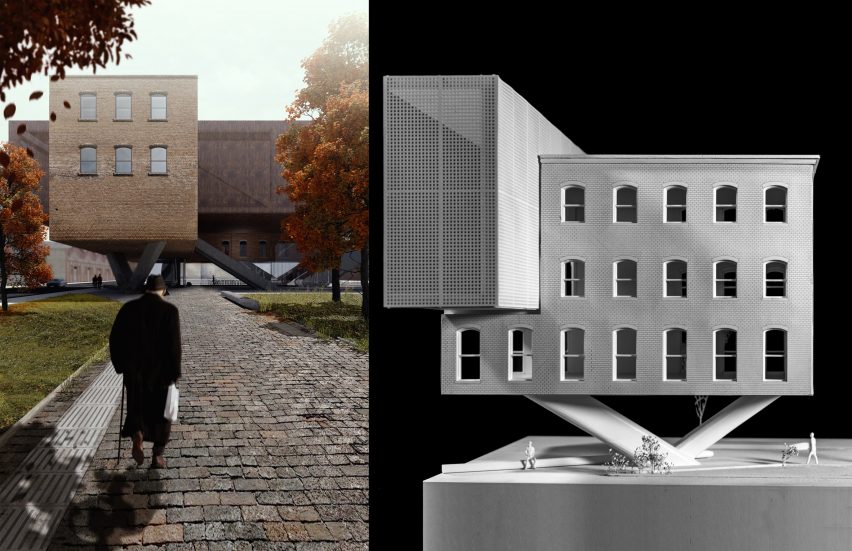
Suspending Volume by Logan Ali
"Suspending Volume is a provocation to create a public datum and a novel experience. To achieve this, two of the existing structures are 'cut free' at ground level – they are tied together and hung from a new massing.
"A material and tectonic strategy between the existing volumes and the new structure emphasises suspense. The sweeping gesture at the ground level allows the surrounding urban fabric to extend under and through the project, tying it into its context."
Student: Logan Ali
Course: Fourth Year Design Studio I
Tutor: Matthew Hutchinson
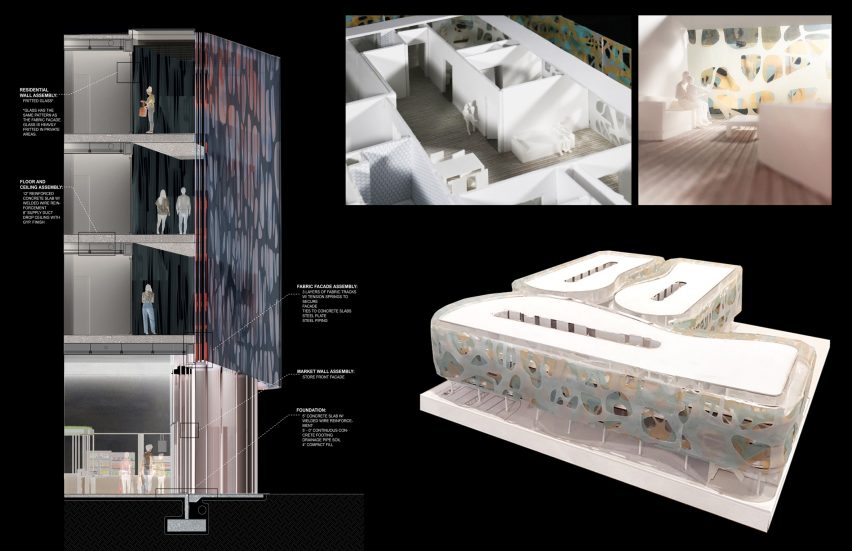
Kaleidoscope by Olivia Newbrough and Josie Estlock
"Kaleidoscope is a mixed-use building that explores the movements that occur in the facade as users walk through the external circulation space.
"As you walk through this space, you can see through the three layers of the facade's fabric, allowing you to observe various colours and moments like a kaleidoscope.
"You may perceive different views of the structure, colours and the surrounding site when you walk through it. Due to the layers of transparency, you may experience a different effect based on where you are in the building.
"From the street level, the facade layers tend to become more opaque, meaning that those within the units and circulation space experience a much more transparent building envelope than someone on the street.
"It becomes harder to identify the number of floors in the building from the street level since the building appears to be a large mass due to the opacity."
Students: Olivia Newbrough and Josie Estlock
Course: Integrated Design Studio
Tutor: Jonathan MacGillis
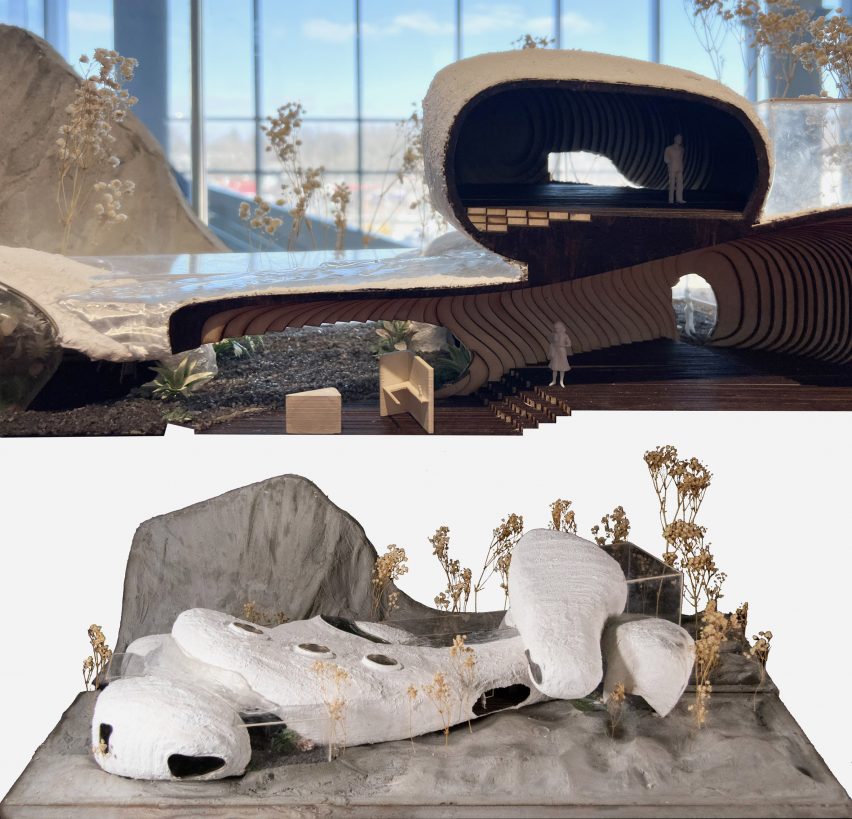
Vivarium by Ryan Coberly
"Vivarium consists of multiple manipulated programmes of 'bubbles' connected by a green corridor that mimics the ecology of the site. The section model is a physical manifestation of a vivarium or geode.
"The exterior is a curvilinear and soft shape that, when broken apart, reveals spaces that begin to come alive through the use of various colours, textures and vegetative details.
"Where the corridor meets the fully transparent exterior glass, the separation between the interior and exterior is blurred.
"The fabrication process included experimenting with glass, resin, acrylic and other materials to understand how they operate as lenses that obscure one's view from the inside to the outside.
"By doing so, the lenses are not limited to their inherent use as a single view port but can now serve as a crafted piece of furniture that can be occupied within a space."
Student: Ryan Coberly
Course: Third Year Design Studio II
Tutor: Ivàn Bernal
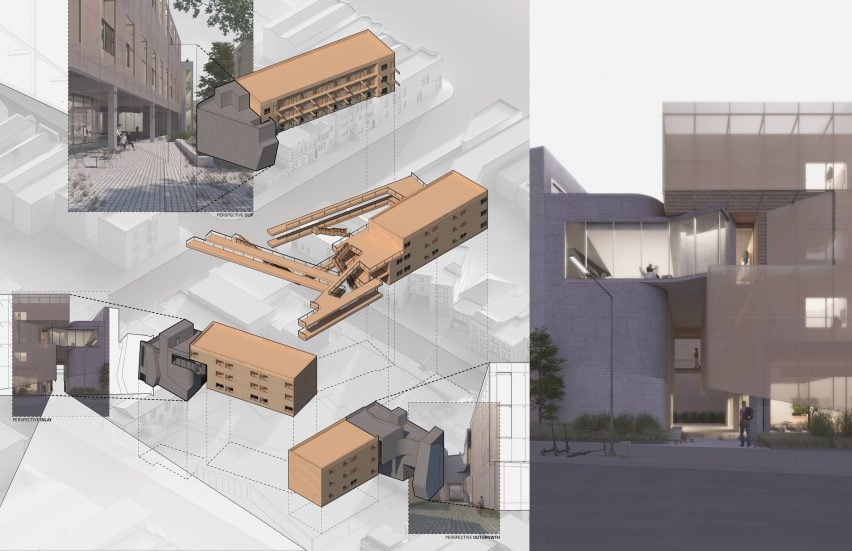
Mission District Transitional Housing by Logan West and Logan Ali
"This project reframes the core of the building to support social infrastructures spatially and emphasise building infrastructure collectivity.
"Not compromising the core's infrastructural efficiencies and means of egress, this project envisions the core as a social condenser where shared amenities serve the transitional housing complex.
"The feeling of social isolation is a common psychological burden of those facing homelessness. The design emphasises the shared spatial conditions that are arranged within the site boundaries as urban objects.
"They contain shared social spaces – each core influences the organisation of disparate housing blocks and their circulatory network that frame the large urban rooms."
Students: Logan West and Logan Ali
Course: Integrated Design Studio
Tutor: Nick Safley
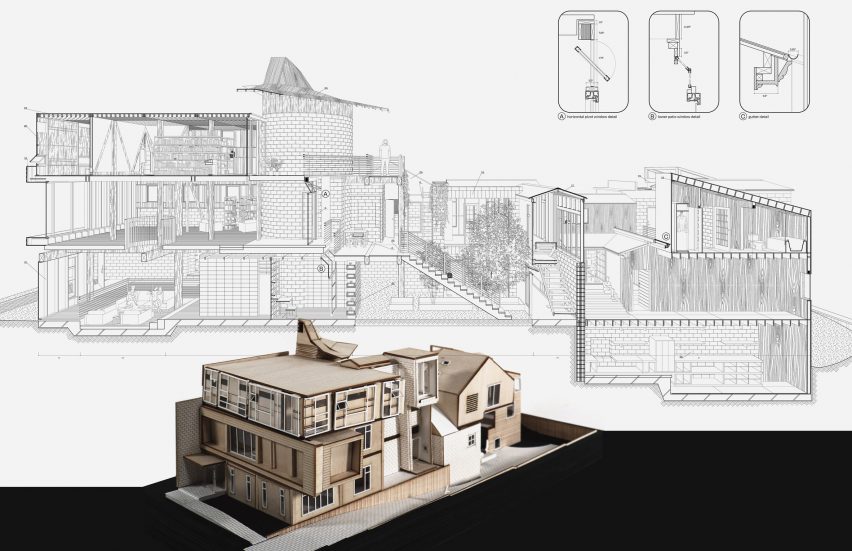
Building for Collective Living by Trevor Rodgers
"Building for Collective Living is a collection of architectural details from a variety of common architectural media and journal sources have been simplified and assembled by a group of collective living members.
"These details are examples of contemporary design with an emphasis on wood stud framing and concrete masonry unit (CMU) construction.
"The performance of the building envelope that utilises these details is generally ineffective as a working facade system, impacting the way natural light infiltrates the building.
"Perspective plans and perspective sections explore aspects of the house by showing instances of materiality, construction techniques and spatial conditions that have varying degrees of efficacy and functionality."
Student: Trevor Rodgers
Course: Graduate Design Studio II
Tutor: Andrew Economos Miller
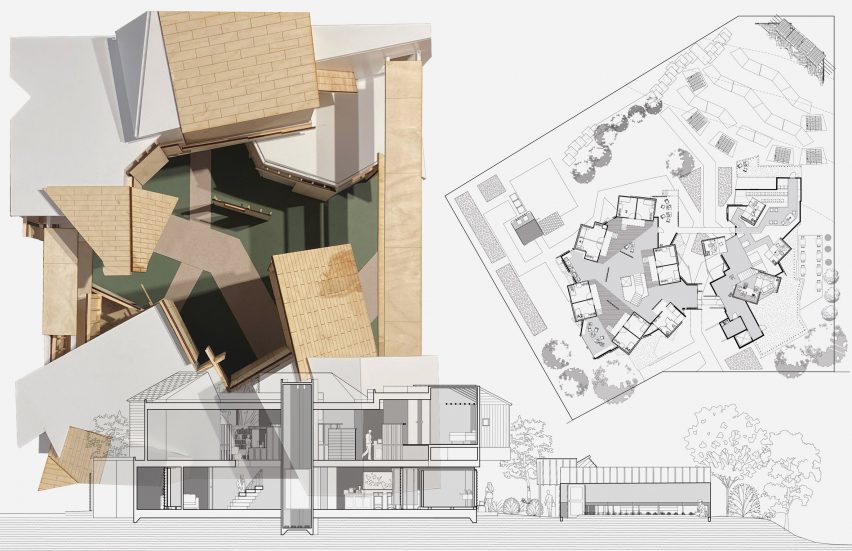
Chunk, Panel and Glue by Tim Gerent and Joseph Norman
"Chunk, Panel and Glue analyses the materiality of condemned houses in Warren, Ohio, USA, on three scales, investigating the reaggregation of the houses and the relationship between the scales of disassembly.
"This postulation led to the creation of different levels of destruction named Chunk, Panel and Glue. Chunk consists of wire cut portions along a secular grid, Panel consists of eight by eight inch planar pieces, and Glue consists of the disassembly at the smallest scale, 'down to the studs'.
"Speculation of how these scales communicate created unique spaces between privatised 'chunks' and more open communal spaces are defined through new structures and 'panels'.
"These defined spaces allowed for the 'glue' to negotiate between the two defined spaces, providing communal and privatised spaces for residents throughout neighbourhoods as well as a bridging system.
"These systems were then used to influence how we viewed the way spaces interacted with the occupant and how the spaces influenced their mental health.
"The reconstructed co-housing community looks to further address the socio-economic and environmental impacts that play a role in mental health today."
Students: Tim Gerent and Joseph Norman
Course: Third Year Design Studio I
Tutor: Andrew Economos Miller
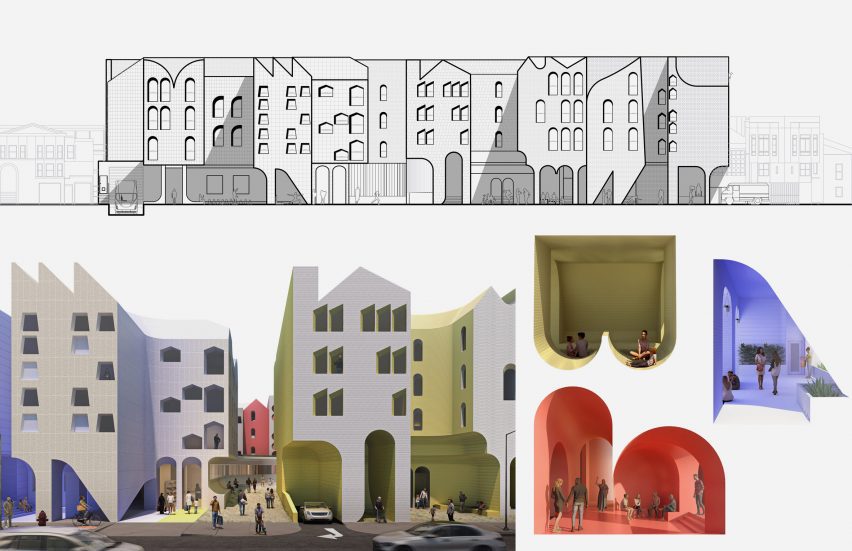
Shaping Community by Justin Levelle and Dominic Holiday
"Shaping Community explores the use of anthropomorphic forms and spaces to create a varied social framework with a participatory way of living.
"The use of legs, bodies and hats as narrative characters gives residents a sense of shared identity from the public. As these forms move into the site's interior, they warp and intersect.
"This allows users to participate within the multiple characters that act as places for repose, gathering or amusement. The combination of figures and subfigures from characters create open social spaces at the street edge that extend into the site and facilitate different collective living.
"The building uses a three-over-one construction strategy to prioritise the shaping of the ground as well as the flexibility of organisation that comes from wood framing.
"The vertical circulation, variable refrigerant flow (VRF) heating and cooling, plumbing and rooftop operate on the scale of the characters – these characters provide a sense of identity and privacy to the residents.
"The 'legs' of the characters promote a sense of collectivity within the grocery store and the general public, whereas the 'hats' create a sense of privacy within the community."
Students: Justin Levelle and Dominic Holiday
Course: Integrated Design Studio
Tutor: Nick Safley
Partnership content
This school show is a partnership between Dezeen and Kent State University. Find out more about Dezeen partnership content here.